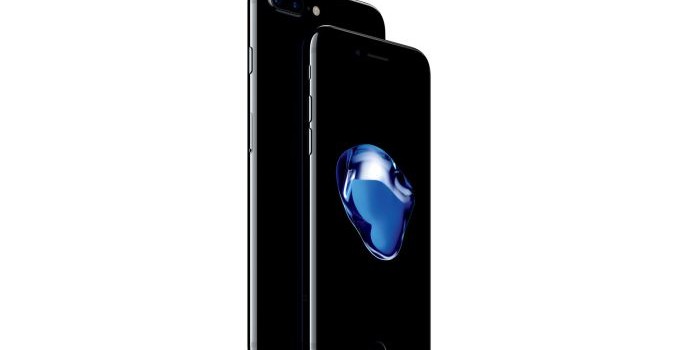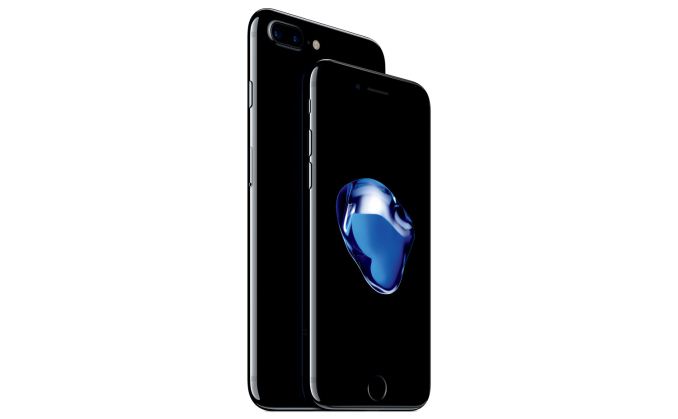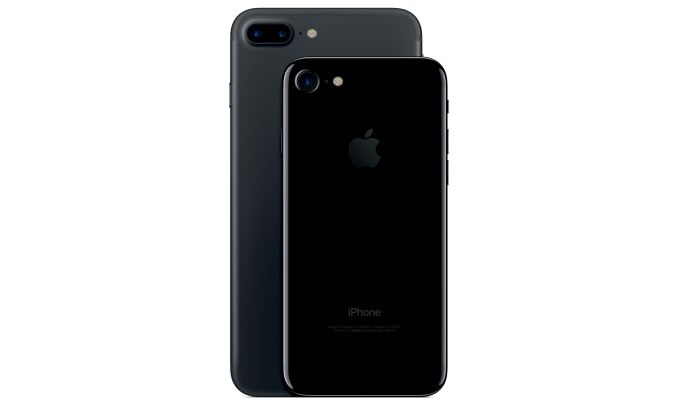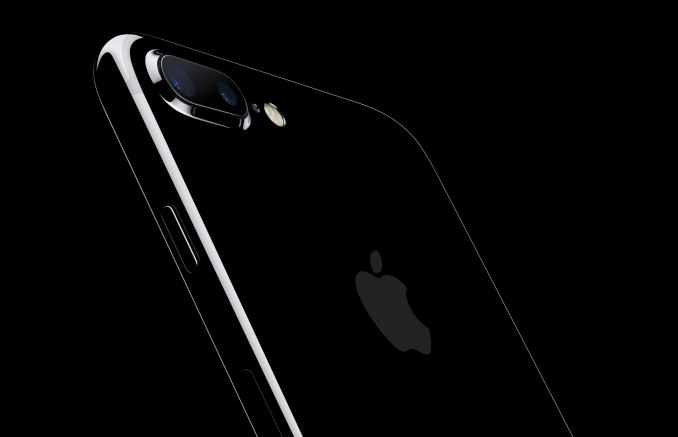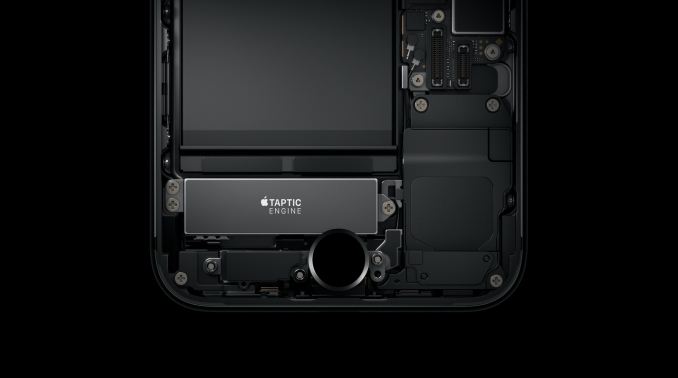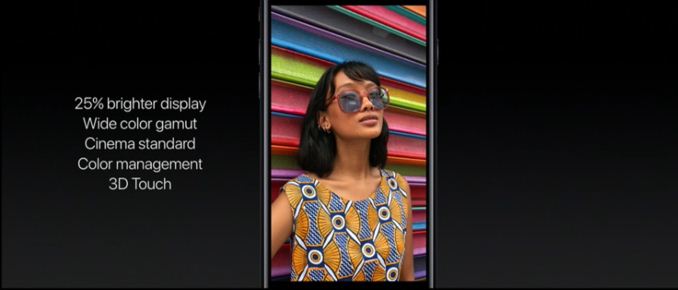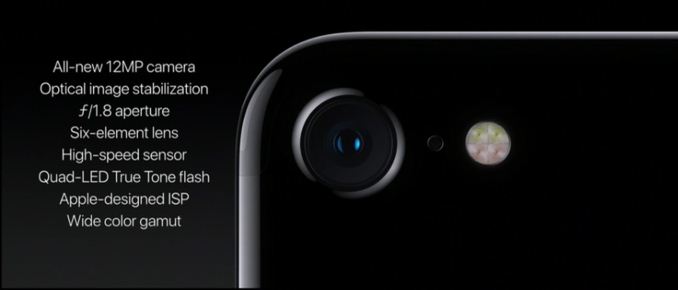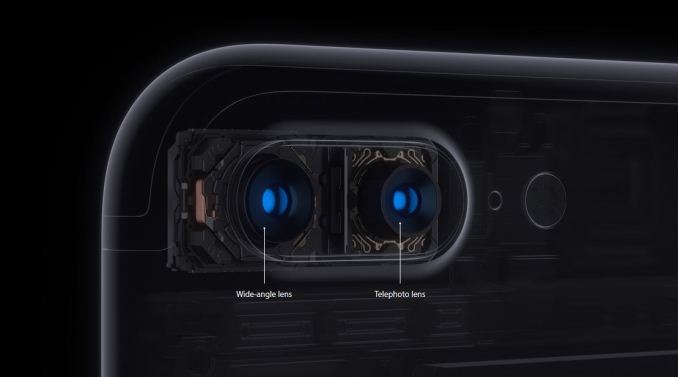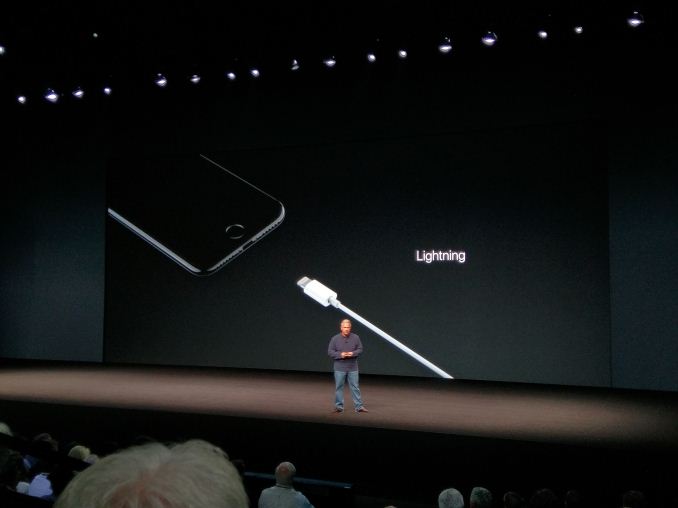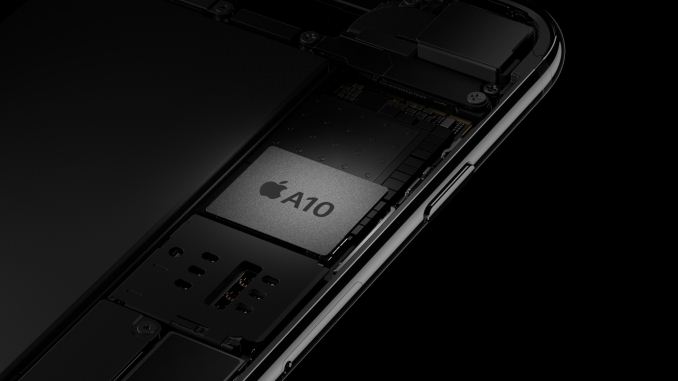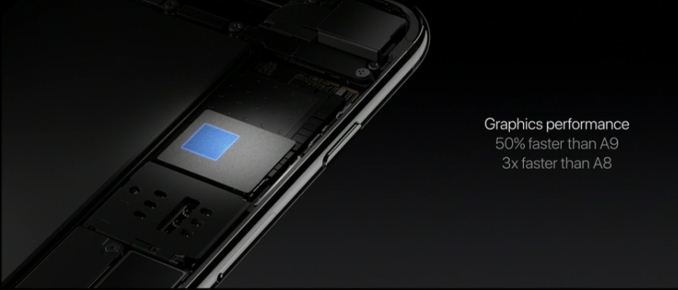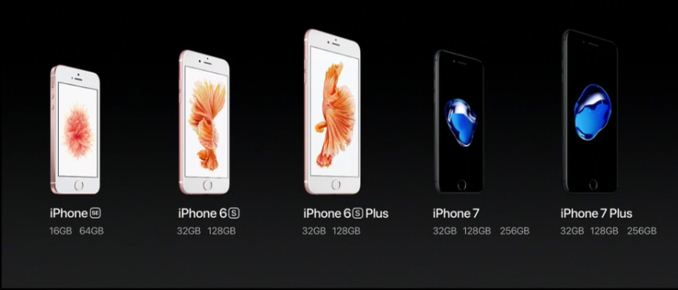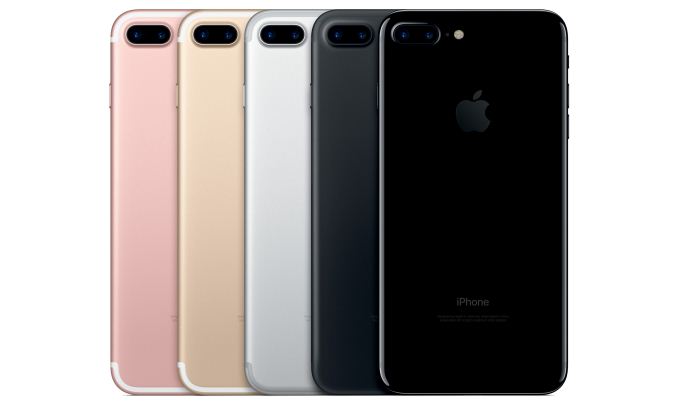Apple Announces iPhone 7 & iPhone 7 Plus: A10 Fusion SoC, New Camera, Wide Color Gamut, Preorders Start Sept. 9th
Today at Apple’s annual iPhone event held in San Francisco’s Bill Graham Civic Auditorium, the company announced their next generation of iPhones: the iPhone 7 and the iPhone 7 Plus. As you might expect from Apple’s history, the two phones incorporate a number of new features and feature upgrades compared to their immediate predecessors. This includes a new SoC – the A10 Fusion – new camera options, IP67 water resistance, and top-to-bottom support for both wide color gamut (DCI-P3) displays and photography.
| Apple iPhone 7 and 7 Plus | ||||
| Apple iPhone 7 | Apple iPhone 7 Plus | Apple iPhone 6s | Apple iPhone 6s Plus | |
| SoC | Apple A10 Fusion 2 x "Fast Core" 2x "Efficient Core " |
Apple A9 2 x 1.85GHz Apple Twister |
||
| GPU | "6 Core GPU" | PowerVR GT7600 | ||
| Display | 4.7-inch 1334 x 750 IPS LCD, DCI-P3 | 5.5-inch 1920 x 1080 IPS LCD, DCI-P3 | 4.7-inch 1334 x 750 IPS LCD, sRGB | 5.5-inch 1920 x 1080 IPS LCD, sRGB |
| Size / Mass | 138.3 x 67.1 x 7.1 mm, 138 grams | 158.2 x 77.9 x 7.3 mm, 188 grams | 138.3 x 67.1 x 7.1 mm, 143 grams | 158.2 x 77.9 x 7.3mm, 192 grams |
| Rear Cameras | 12MP ƒ/1.8 OIS, Wide Color Gamut, Quad LED True Tone Flash |
12MP ƒ/1.8 wide angle, OIS, Wide Color Gamut, Quad LED True Tone Flash 12MP ƒ/2.8 telephoto, |
12MP with 1.22µm pixels + True Tone Flash | 12MP with 1.22µm pixels + True Tone Flash + OIS |
| Front Camera | 7MP ƒ/2.2, Wide Color Gamut, Retina Flash | 7MP ƒ/2.2, Wide Color Gamut, Retina Flash | 5MP F/2.2 + Retina Flash |
5MP F/2.2 + Retina Flash |
| Storage | 32GB/128GB/256GB | 16GB/64GB/128GB (Launch) 32GB/128GB (Refresh) |
||
| I/O | Apple Lightning connector | Apple Lightning connector, 3.5mm headset | ||
| WiFi | 2.4/5GHz 2×2 802.11a/b/g/n/ac, BT 4.2, NFC | 2.4/5GHz 2×2 802.11a/b/g/n/ac, BT 4.2, NFC | ||
| Launch Price | $649/749/849 32/128/256GB | $769/869/969 32/128/256GB | $649/749/849 16/64/128GB | $749/849/949 16GB/64/128GB |
Jumping right into the heart of matters, in previous years Apple has alternated their upgrades between the overall design of the phone and focusing on the internal processors, resulting in the usual iPhone (X) and iPhone (X)s cadence we’ve seen over the past several years. For the iPhone 7, Apple has kept with this general development process, however relative to the iPhone 6 and 6s generations, the iPhone 7 isn’t quite as significantly a departure as past designs.
Design & Features
The overall body of the iPhone 7 series is rather similar to the iPhone 6 series. Both the regular and the Plus phones have virtually the same dimensions as their 6s predecessors, so the size of the phones is unchanged. Button placement also hasn’t changed, with volume and power buttons on the left and right sides of the phones respectively. The curved design of the iPhone series has also been retained.
So what is new for the iPhone design? In short, water resistance and a lot of polish. Apple has finally added more complete water resistance into the iPhone design for the iPhone 7 series, and the latest phones are IP67 rated for water resistance. Like we’ve seen with other IP67 phones, it should be noted that water “resistance” is the key word there; this level of protection is designed to resist water damage to the phone in the case of accidents, and it’s not meant for long-term submersion (swimming and the like).
Meanwhile on the polish side, for this generation Apple has further refined the overall design of the iPhone. Apple has taken a particular interest in going “seamless” this generation, further reducing the presence of seems in the phone where the glass meets the case and along the antenna bands. Apple has also introduced some new color options here: a matte black finish (seemingly replacing Space Grey), and a glossy “jet black” finish, the latter of which literally involves a polishing process. Apple is treating the jet black finish is this generation’s premium finish option, and as a result it is only available on the more expensive 128GB and 256GB phone models.
However the biggest change here is probably the home button, which is now entirely solid state. Apple has integrated their force touch technology previously used for the iPhone 6s screen and the MacBook trackpads into the home button, removing the mechanical aspects of it. Instead, like the aforementioned devices, what you’re looking at is a pressure-sensitive surface with the taptic engine being used to simulate the necessary feedback. The home button was one of the last few mechanical parts in the iPhone, and Apple is touting this as improving the reliability of the button. At the same time I wouldn’t be surprised if it was also part of the work that went into making the phone water resistant. It will also be interesting to see what Apple eventually does with the pressure sensitivity, given that they’ve tried to make it an important part of the user experience with the iPhone 6s and its force touch screen.
On the display side of matters, Apple has taken a page from this year’s 9.7” iPad Pro launch and upgraded the iPhone for DCI-P3 wide color gamut support. Apple has increasingly been going DCI-P3 capable throughout its entire product lineup, and P3 is quickly becoming by far the most commonly supported of the wide gamut standards across the industry. In the case of the iPhone 7, this is part of a larger upgrade to implement top-to-bottom wide color gamut support, with the phone’s cameras also getting a similar upgrade. The advantage of the larger color gamut, as we’ve seen with the iPad, is that it allows for representation of “deeper” colors that can’t be covered by the traditional sRGB color space, ultimately getting closer to reproducing the full spectrum of what humans can see. As pointed out by our own Brandon Chester however, these new phones don’t include the iPad’s True Tone capability, which allows the display’s white point to be changed with the color temperature of the surrounding lighting.
Along with the addition of wide color gamut support, the panels in the new iPhones are also 25% brighter according to Apple, with a typical max brightness of 625 nits (for reference, we measured the max brightness of the iPhone 6s at 567 nits, compared to an official spec of 500 nits). What hasn’t changed however is resolution; these are still Retina HD displays, meaning we’re looking at 1334×750 pixels for the 4.7” iPhone 7, and 1920×1080 pixels for the iPhone 7 Plus.
At the other end of the spectrum then are the iPhone 7 series’ new rear and front facing cameras. Starting with the iPhone 7, Apple has retained a 12MP sensor (sensor manufacturer unknown), however they have significantly improved the feature set available. The new camera module is capable of taking wide color gamut photos to go along with the WCG-capable display. Furthermore, in a rarity for a sub-5” phone, the iPhone 7 now includes optical image stabilization (OIS) for both photos and video recording, a feature that was previously only available on the larger Plus phones. The new camera is composed of a six element lens, and along with its other improvements, the sensor is said to be 60% faster and 30% more energy efficient than the previous-generation sensor in the iPhone 6s. Also augmenting the new camera is an updated true tone flash light; the new module is composed of 4 LEDs, allowing for what Apple says is 50% more illumination than the iPhone 6s.
Meanwhile for the iPhone 7 Plus, Apple has added a second 12MP camera. What sets this second camera apart from the first is the lens; complementing the normal wide-angle lens on the primary camera, the second camera uses a 56mm, f/2.8 telephoto lens, offering a tighter picture with an effective 2x optical zoom over the primary camera. Apple has been pushing the camera aspect of the iPhone for many years now, and with the latest iPhone they are branching out into one of the few things most smartphone cameras haven’t been able to address with optical zoom. Besides allowing for closer photos, the second camera will also be used to do depth measurements, allowing the iPhone 7 Plus to do depth of field effects.
Finally, both phones have also received a new front facing camera. This new camera is 7MP, and like its rear facing counterparts supports wide color gamut photos.
As for audio capabilities, Apple has taken both a step forward and a step back. Moving forward, the headset speaker towards the top of the phone has been upgraded to be a full-fledged, full volume speaker. As a result, the iPhone can now play back stereo sound when in landscape mode by combining this with existing speaker at the bottom of the phone. Apple says the new speaker system is 2x louder – though it’s not clear if this is just adding up the output of the two speakers – and we’re told that the iPhone 7’s speakers support a greater dynamic range.
However taking a step back, as rumors have previously indicated, Apple has removed the 3.5mm audio jack on the phone. For external audio, Apple is now telling users and accessory manufacturers alike to use the Lightning port. Of note, this necessitates putting a Digital to Analog Converter (DAC) in headphones and other devices that directly connect via Lightning, which is going to have interesting ramifications on audio quality differences between products and how they are priced. Otherwise for existing 3.5mm devices, Apple is also including a Lighting to 3.5mm audio adapter, which of course also integrates the necessary DAC.
Given that they’re removed the audio jack, Apple has upgraded their EarPod earbuds for the new iPhone. The new models are lightning based, though otherwise apparently unchanged from their predecessors. A bit farther down the line, Apple will be releasing a wireless earbud product, the AirPods, with which they intend to do away with concerns about wired connections entirely by going wireless.
A10 Fusion: The Next Apple SoC
Finally, last but certainly not least is the heart of the iPhone 7 and 7 Plus: the SoC. While Apple has traditionally focused on bigger improvements in the off-year s-generation updates, they have made something of an exception for the iPhone 7 with the A10 Fusion SoC.
The major change here is that with the A10, Apple has embraced the concept of multiple types of CPUs, each with different power/performance characteristics. This is something that has been prevalent in SoCs based around ARM Cortex-A CPU designs used in most Android phones, but Apple had (until now) opted to stay with a single cluster of two CPU cores.
There’s a lot of information to chew here, and a product announcement isn’t nearly enough to cover everything, but the basic theory behind a multi-type/multi-cluster design is to further min/max power efficiency by developing a set of high performance, high power cores for tasks that need maximum performance, and a second set of low performance, low power cores for simpler tasks that need only a small amount of computational time. By not sending the latter tasks to the high power cores, in theory you save on power consumption. This is the basis behind ARM’s big.LITTLE design philosophy.
The trade-off with this philosophy is that you now have to manage migrating tasks between the CPU clusters, which itself has a power cost. So while it’s a more efficient route in theory, in practice it can be difficult to implement, especially in a performant manner. Apple has previously stuck with their single cluster design, using the same CPU cores to run the gamut from low power to high performance, and while we may never get a full answer, I am very curious what happened behind the scenes at Apple and what they found to get to this point.
In any case, the A10 implements two types of cores; a pair of high performance cores, and a pair of low power cores. The slower cores are said to consume one-fifth the power of the high performance cores, though Apple has not indicated what performance is like. As is traditional for Apple, they haven’t said anything about the CPU cores themselves, but it’s a safe bet that the high performance cores are a direct descendant of the Twister cores used in the A9. More curious will be what the low-power cores are – given Apple’s fondness for developing their own ARM CPU cores and various technical considerations (such as the core interfaces), it may very well be that these are also Apple-designed cores, as opposed to an off-the-shelf solution like ARM’s Cortex-A53.
One thing Apple has emphasized in talking about the A10 is that their design uses a custom designed performance controller to manage the CPU cores and migrate tasks between them. This revelation of a hardware controller does imply that Apple is using some form of cluster or CPU migration – that is, only ever using 2 cores at once and not using all 4 cores at the same time in a heterogeneous manner – but all of this is speculation and subject to confirmation. Either way, this is the biggest change to the structure of Apple’s CPU subsystem since A7 and the Cyclone CPU core in 2013, and given Apple's habit of throwing us curveballs on the SoC side, I suspect the answer is not as simple as what we currently believe.
Meanwhile on the GPU side, Apple has uncharacteristically confirmed that A10 implements a “6 cluster” GPU design. This removes a good bit of guessing work here, as the significant scalability of GPUs has always made it difficult to pin down the number of GPU clusters. A good bet here is that Apple is using another PowerVR design – either a higher clocked version of the PowerVR GT7600 used in the A9, or perhaps a six cluster design based on the more recent PowerVR Series7XT Plus architecture – but that’s something that remains to be seen.
From a performance standpoint Apple is once again touting significant performance gains versus the A9 and previous SoCs. CPU performance (of the high power cores) is said to be 40% better than the A9 and its dual 1.85GHz Twister CPU cores. Meanwhile GPU performance is said to be 50% higher than A9’s PowerVR GT7600 GPU. Obviously we’ll have to see how well performance holds up in our benchmarks, but if Apple can actually deliver on these claims then this would be a significant gain for a non-s generation product, and one made all the more impressive as Apple will not have received the advantages of a die shrink with this generation.
Finally, no information about the RAM paired with the A10 is available at this time. However we’re very happy to see that the traditionally conservative Apple has finally given the iPhone line a bump in NAND capacity. The entry-level model is now 32GB, and the higher capacity tiers have been bumped to 128GB and 256GB respectively.
Final Words
As for battery life, Apple has not released any hard details on the capacity of the batteries being used in the iPhone 7 and the 7 Plus. However they are claiming yet another increase in average battery life. Overall Apple says the average increase for the iPhone 7 over the 6s is 2 hours, and a smaller 1 hour increase for the iPhone 7 Plus over the iPhone 6s Plus. Curiously, Apple’s official 3G talk time numbers are the same (or have regressed) compared to the iPhone 6s, at 14 hours for both the iPhone 6s and iPhone 7. Instead Apple’s metric of choice is LTE internet use, which on the same phones has increased from 10 hours to 12 hours. So at first glance, assuming Apple hasn’t regressed on modem power usage, these power gains would seem to come from improvements to the A10 SoC and possibly the display.
Wrapping things up, Apple is going to be bringing the new iPhones to market rather quickly. Pre-orders for the phones open up on the 9th, and they’ll begin shipping one week later on the 16th. Phone pricing for the iPhone 7 is unchanged from the iPhone 6s, with the base 32GB model starting at $649 and each capacity bump going up $100 from there. Meanwhile the iPhone 7 Plus is just a bit more expensive, seeing a price bump at all capacities of $20, putting the starting price at $769.

